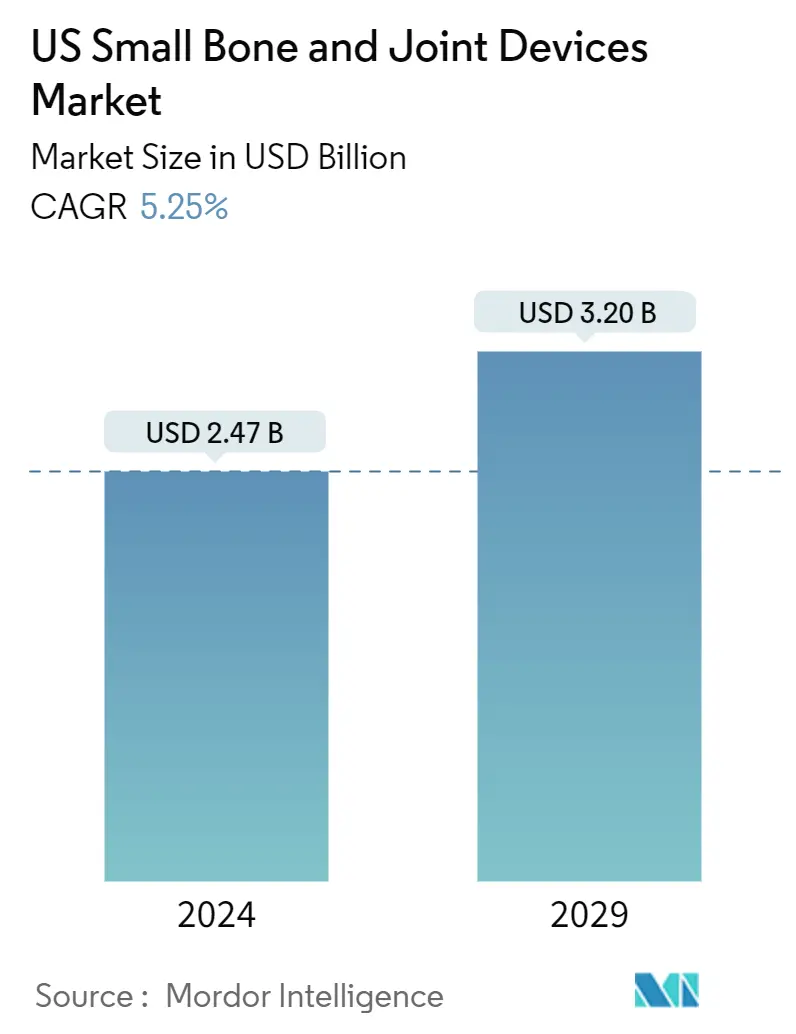Market Size of US Small Bone And Joint Devices Industry

| Study Period | 2019 - 2029 |
| Base Year For Estimation | 2023 |
| Forecast Data Period | 2024 - 2029 |
| Market Size (2024) | USD 2.47 Billion |
| Market Size (2029) | USD 3.20 Billion |
| CAGR (2024 - 2029) | 5.25 % |
Major Players
*Disclaimer: Major Players sorted in no particular order |
US Small Bone and Joint Devices Market Analysis
The US Small Bone And Joint Devices Market size is estimated at USD 2.47 billion in 2024, and is expected to reach USD 3.20 billion by 2029, growing at a CAGR of 5.25% during the forecast period (2024-2029).
The COVID-19 pandemic had an impact on the small bone and joint market in the United States, as the country's hospitals and clinics were significantly disrupted in the initial phase of the pandemic. For instance, according to a research study published in the Journal of Hand Surgery Global Online in November 2021, during the COVID-19 pandemic, the volume of common hand and wrist surgeries varied significantly by the healthcare organization. Significant decreases in procedural volume corresponded with increases in COVID-19 caseloads and the emergence of COVID-19 variants. Therefore, the COVID-19 pandemic had a significant impact on the small bone and orthopedic devices market initially. However, since the restrictions were eased, the market is likely to witness growth in the coming years due to the resumption of surgical activities, manufacturing of medical devices, and new product approvals in the small bone and joint devices market.
The rising prevalence of degenerative joint diseases, along with the increasing geriatric population in the United States, are the major drivers for the growth of the small bone and joint devices market during the forecast period.
The elderly population is more prone to various bone and joint disorders, and the geriatric population in the United States is increasing, which is further expected to increase the burden on the bones and joints and increase the growth of the small bone and joint devices market in the United States. For instance, according to the 2022 statistics published by the United Nations Population Fund, in the United States, a large proportion of the population was estimated to be aged 15-64 and accounts for 65% in 2022. In addition, as per the same source, 17% of the population was aged 65 years and above in 2022. Thus, the expected increase in the geriatric population will increase the demand for small bone and joint devices, thereby boosting market growth.
Moreover, rising demand for joint surgeries is expected to boost the market for small bones and joint devices over the forecast period. Road accidents often lead to shoulder, foot, or ankle surgeries. Increasing cases of road accidents and sports injuries are further fueling the chances of surgeries. For instance, according to an article published in March 2021, nearly 124,000 industrial hand injuries occur in the United States each year, and a large percentage of the population suffers from degenerative hand diseases, which is expected to increase the demand for small bone and joint devices over the forecast period.
In addition, increasing research and development activities in the country associated with the market are expected to boost the market. For instance, in February 2022, Cerapedics Inc., an ortho-biological company dedicated to advancing the science of bone repair, initiated the ASPIRE study, a pivotal US Food and Drug Administration (FDA) Investigational Device Exemption (IDE) study to evaluate the safety and efficacy of P-15L bone graft for use in transforaminal lumbar interbody fusion (TLIF) surgery in patients with degenerative disc disease (DDD).
In addition, technological innovations, the introduction of new devices, company mergers and acquisitions, and other business expansion initiatives are expected to further fuel the growth of the small bones and joint devices market. For instance, in May 2021, Orthopedic Implants announced US FDA clearance and the commercial launch of its wrist fracture plating technology, the DRPxSystem. DRPx is the distal radius plating system that features an improved ergonomic design that meets the technical preferences of orthopedic surgeons while significantly increasing cost savings, helping to improve the financial viability of ambulatory surgery centers (ASCs) and hospitals.
Thus, owing to the above-mentioned factors, such as the rising burden of orthopedic diseases and geriatric population product launches, the studied market is expected to grow significantly during the study period in the country. However, strict regulatory policies for bone and joint devices in the country are expected to restrain the growth of the small bone and joint devices market in the United States during the forecast period of the study.
US Small Bone and Joint Devices Industry Segmentation
As per the scope of the report, when the articular cartilage is worn out or damaged, the gliding movements of the bones are disrupted, and small bone and joint devices are employed. These devices allow joints to extend their range of motion, improving their look and allowing them to move without discomfort again. The United States small bone and joint devices market is segmented by device type (hand and wrist devices, foot and ankle devices, and other devices) and end user (hospitals, clinics, and other end users). The report offers the value (in USD) for the above-mentioned segments.
| By Device Type | |
| Hand and Wrist Devices | |
| Foot and Ankle Devices | |
| Other Devices |
| By End User | |
| Hospitals | |
| Clinic | |
| Other End Users |
US Small Bone And Joint Devices Market Size Summary
The US small bone and joint devices market is poised for significant growth over the forecast period, driven by several key factors. The market is recovering from the initial disruptions caused by the COVID-19 pandemic, which had a notable impact on surgical procedures and the demand for orthopedic devices. As surgical activities resume and new product approvals increase, the market is expected to expand. The rising prevalence of degenerative joint diseases and the growing geriatric population in the United States are major contributors to this growth. The elderly population, being more susceptible to bone and joint disorders, is anticipated to drive demand for small bone and joint devices. Additionally, the increasing incidence of road accidents and sports injuries is expected to boost the need for joint surgeries, further propelling market expansion.
Technological advancements, research and development activities, and strategic business initiatives such as mergers and acquisitions are also expected to fuel market growth. The introduction of innovative devices and systems, like the WristMotion Total Wrist Arthroplasty system and the DRPx distal radius plating system, highlights the ongoing advancements in the field. The hand and wrist segment, in particular, is expected to capture a significant market share due to the high prevalence of musculoskeletal disorders and the increasing number of product launches. The hospital segment is witnessing rapid growth, supported by the rising number of hospitals and the demand for advanced surgical equipment. Key players such as Stryker Corporation, Zimmer Biomet, and Johnson & Johnson (DePuy Synthes) are dominating the market, contributing to its competitive landscape. Overall, the US small bone and joint devices market is set to experience robust growth, driven by demographic trends, technological innovations, and strategic market activities.
US Small Bone And Joint Devices Market Size - Table of Contents
-
1. MARKET DYNAMICS
-
1.1 Market Drivers
-
1.1.1 Increasing Prevalence of Degenerative Joint Diseases and Growing Geriatric Population
-
1.1.2 Technological Advancements and Growing Demand for Joint Surgeries
-
-
1.2 Market Restraints
-
1.2.1 Stringent Regulatory Policies
-
-
1.3 Porter's Five Forces Analysis
-
1.3.1 Threat of New Entrants
-
1.3.2 Bargaining Power of Buyers/Consumers
-
1.3.3 Bargaining Power of Suppliers
-
1.3.4 Threat of Substitute Products
-
1.3.5 Intensity of Competitive Rivalry
-
-
-
2. MARKET SEGMENTATION (Market Size by Value - in USD Million)
-
2.1 By Device Type
-
2.1.1 Hand and Wrist Devices
-
2.1.2 Foot and Ankle Devices
-
2.1.3 Other Devices
-
-
2.2 By End User
-
2.2.1 Hospitals
-
2.2.2 Clinic
-
2.2.3 Other End Users
-
-
US Small Bone And Joint Devices Market Size FAQs
How big is the US Small Bone And Joint Devices Market?
The US Small Bone And Joint Devices Market size is expected to reach USD 2.47 billion in 2024 and grow at a CAGR of 5.25% to reach USD 3.20 billion by 2029.
What is the current US Small Bone And Joint Devices Market size?
In 2024, the US Small Bone And Joint Devices Market size is expected to reach USD 2.47 billion.

